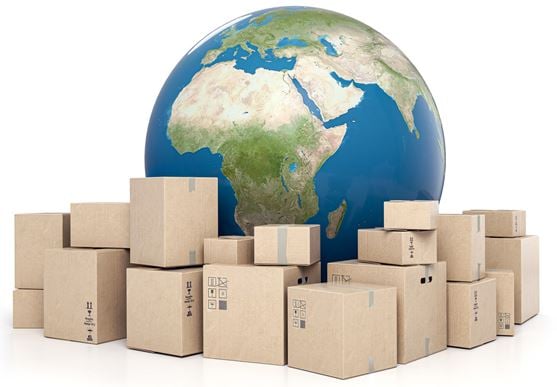
Thinking about shipping a package internationally? If you’re rusty on how the process works or have never shipped a package overseas before, this article is for you.
So, how does international shipping work? We’ve created a step-by-step guide on the best practices for getting it done.
Ready to send your package across the world safely? Want to save time and money in the process? Read on.
-
Know What to Pack (And What Not to Pack)
Fireworks and coral and soil, oh my! There are a surprising amount of things that are banned from shipping overseas. Check the shipping regulations to make sure you’re complying with national and international shipping policies before you agree to ship anything.
Wondering where to look? This international shipping guide provides details on general international shipping regulations and what’s banned in specific countries.
-
How Does International Shipping Work When Suspensions are in Place?
Since packages typically travel on commercial flights, the reduced availability of international flights has caused major delays in shipping. Countries are also taking additional precautions to make sure their products are virus-free before they’re sent out and are experiencing warehouse shortages, which delay the arrival of international mail further.
If you’re wondering how long it might take for your package to get to its destination, check to see if there are any shipping suspensions in place. The United States Postal Services updates their list of current shipping suspensions by country frequently.
Fortunately, the list of suspensions is growing smaller over time, and there are plenty of countries that aren’t facing shipping suspensions at all. For instance, if you’re looking to ship from Mexico (or to it), you’re in luck! Currently, there aren’t any international shipping suspensions to and from this country.
-
Protect Your Products
Ready to prepare your package for shipping? You’re going to want to make sure it’s ready for a bumpy ride. While handlers will do all they can to ensure your package arrives safely, your package has a long road ahead.
Once it ships out, it will experience multiple transfers between land and air carriers (and possibly ships) along its route. To decrease its likelihood of becoming damaged along the way, make sure you’re using exterior packaging that’s sturdy enough to last during this journey, along with plenty of packing peanuts or bubble wrap if the package contents are fragile.
Shipping something that needs to stay cool along the way? Know how to keep items cold while they’re en route, and pack accordingly.
-
Consider Costs and Compare Shipping Prices
A major factor in international shipping costs is the overall distance traveled. The further the distance, the more expensive it will be. However, there are additional factors to determine international shipping costs:
Shipping Agency
Prices vary depending on the company you’re shipping with. Review their prices listed online or call one of their stores for price estimates before choosing your company.
Time
Consider how soon the package needs to reach its destination. If it contains perishable items, it’ll need faster shipping.
You’ll also want to check with the package recipient to see how soon they need the package. If it’s time-sensitive, look into faster shipping methods (such as priority shipping) to get it there sooner.
Weight and Size of Package
If you want to estimate the cost of the shipping, weigh the contents and packing materials if you have them. If there is anything you can remove to make the package lighter, you can reduce shipping costs.
You can also look into shipping boxes. Some companies offer flat rates when you use their boxes, so if you measure the dimensions of the package contents, you may discover a cheaper shipping option.
-
Complete and Review the Documentation
Before you send your package off, you’ll need to complete shipping customs forms. Some of the questions to expect are the names and addresses of the shipper and recipient, as well as what contents are in the package.
Complete the documentation in full and don’t skip any lines. Once you’ve completed the requested forms, review them carefully to make sure it’s complete and accurate. If the information you’ve entered is inaccurate, you could risk delayed shipping, product damage, and even felony charges if they find you intentionally falsified information.
-
Keep a Paper Trail
Once you complete the documentation process, you’ll get carbon copies of everything you filled out. Keep those documents and your receipt in a safe place in case there are any discrepancies with the package along the way. Many shipping agencies won’t provide you with any information about the status of the package if you don’t have the tracking information—even if you can provide every other detail to them.
-
Inform Your Recipient
Provide an update to the package recipient to let them know that you’ve shipped the product. Got that receipt handy? Send an image of it to your recipient.
This information will let them know how much they owe you if they’re reimbursing you for shipping and will provide them with important shipping information, such as the shipping plan and tracking number.
Sharing the tracking number will also let them track the package’s status and help them plan to make arrangements to be at that location. Oftentimes, a signature is required to receive these packages.
Up, Up, and Away!
So how does international shipping work? It’s a little more challenging than domestic shipping, but it can be done easily once you know the steps in the process.
Now that you know the secrets of how to send packages internationally, you can prepare your package in confidence. Locate your nearest international shipping agency and get that package overseas in no time.
Interested in learning more tips and tricks to success? Check out more of our articles to learn the best ways of navigating through the business and financial industry.
Video – Logistics
Interesting related article: “What is Logistics?“

